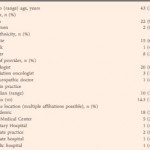Editorial: AS in PCa- New Efforts, New Voices, New Hope
In January 2016, in his final State of the Union address, US President Barack Obama tasked Vice President Joseph Biden with heading up a new national mission, the Cancer Moonshot, to expedite advances in cancer prevention, diagnosis and treatment. One of the blue-ribbon panel recommendations was to minimize the side effects of cancer treatment.
There is no better target for that goal than prostate cancer, the cancer that leads all others in the toll of Americans annually diagnosed with cancer, and the fourth most common worldwide. Many men with low-risk prostate cancer undergo unnecessary treatments, including prostatectomy and radiation therapy, which are unlikely to affect their survival, even if their disease were left untreated. A case in point is the ProtecT study [1], which showed at a median of 10 years that there was no difference in prostate cancer-specific mortality between treatment with surgery or radiation therapy and no treatment [1]. Although there has been a paradigm shift in the management of low-risk prostate cancer with an increased uptake of active surveillance (AS) [2], the fact is that only ~40% of men with low-risk prostate cancer choose AS.
Because of equivalency in effectiveness of treatment options in low-risk prostate cancer, an explication of the steps involved in the clinical decision-making process were long overdue. In an innovative study in the present issue of BJUI, Loeb et al. [3] report a qualitative analysis using a purposive sampling strategy to explore the decision-making process of physicians caring for patients with prostate cancer undergoing AS. This study used qualitative interviews and investigators then analysed responses to identify factors influencing therapeutic decision-making. It is noteworthy that despite the fact that AS acceptance rates have increased and it is an established therapeutic approach, significant differences still remain with regard to when physicians enroll and how they monitor patients on AS. These findings align with those from a Surveillance Epidemiology and End Results (SEER) registry study of 12 068 men with low-risk prostate cancer whose urologists and radiation oncologists reported a spectrum of observation practices [4]. Neither study accounted for patients’ preference or perspectives.
Although there are many national guidelines for AS, no consensus on optimum AS management exists, but Movember–GAP3 (https://au.movember.com/report-cards/view/id/3372/gap3-prostate-cancer-active-surveillance), an international effort comprising 25 institutions with AS programmes, may change that. It seeks to establish standard guidelines for patient selection and monitoring and to find agreement on a trigger for treatment. The tumour heterogeneity and possible lack of linearity in early disease progression that we can glean from the next-generation sequencing studies in advanced prostate cancer [5] will not make that easy. Given the promise of precision medicine, we anticipate a decision-making process that by integrating clinical and pathological data, imaging, and biomarkers prognostic of risk of disease progression as well as patient comorbidity effectively removes guesswork from the calculation.
As this international effort and the vice president’s work proceed, we urge all to listen to the voices of patients and ensure they are heard as clearly as those of the experts. We know the paternalistic model of medicine, in which physicians are the exclusive decision-makers, has long been outmoded [6]. With so much at stake, let us now act like it.



